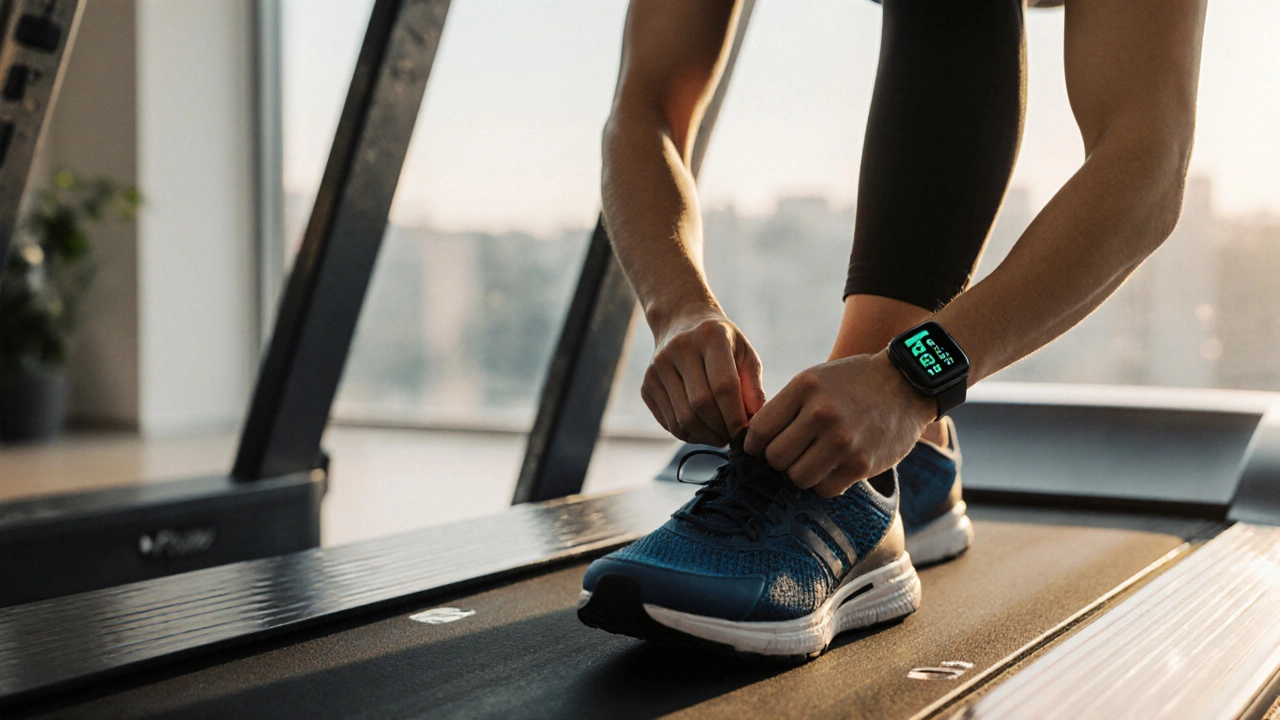Is 20‑Minute Cardio Enough? Benefits, Risks & How to Optimize Your Sessions

20-Minute Cardio Calorie Burn Calculator
Calculate how many calories you burn during a 20-minute cardio session based on your weight, activity type, and intensity level. The formula used is: Calories = MET × body weight (kg) × duration (hours)
Calorie Estimate
Enter your details above to see your calorie burn estimate
How This Works: Calories burned depend on your body weight, activity type, and intensity level. The calculator uses the MET value (Metabolic Equivalent of Task) specific to your activity and intensity to provide an estimate.
Example: A 70kg person running at 6 mph (10 METs) for 20 minutes burns approximately 233 calories. That's equivalent to about 30 minutes of brisk walking (3.5 METs) which would burn about 122 calories.
When you hear "just 20 minutes of cardio", the first thought is often "is that really enough to see results?" The short answer: it can be, if you understand the science behind the timing, intensity, and what you want to achieve. Below we break down how a 20‑minute cardio session fits into a balanced fitness plan, when it works, when it falls short, and how to get the most out of those minutes.
Key Takeaways
- 20 minutes can improve heart health and burn calories, especially at moderate‑to‑high intensity.
- For weight loss or significant endurance gains, combine multiple short sessions or increase frequency.
- Use heart‑rate zones or MET values to tailor intensity and avoid plateaus.
- Pair cardio with strength work for real metabolic benefits.
- Recovery, nutrition, and consistency matter more than a single session length.
What Is Cardio Exercise?
Cardio exercise is a form of aerobic activity that raises your heart rate and breathing for an extended period, using large muscle groups to improve cardiovascular fitness. Classic examples include running, cycling, rowing, and brisk walking. The primary goal is to increase oxygen delivery to muscles, which strengthens the heart, lungs, and blood vessels.
Why 20 Minutes? The Science Behind the Time Frame
Public health guidelines from the World Health Organization recommend at least 150 minutes of moderate‑intensity aerobic activity per week. That works out to roughly 30 minutes a day, five days a week. However, recent research shows that shorter, more intense bouts can also fulfill the weekly quota.
One 2023 study from the American College of Sports Medicine compared 20‑minute moderate‑intensity sessions performed six days a week with a traditional 30‑minute, five‑day schedule. The results showed similar improvements in VO2 max (a measure of aerobic capacity) and comparable reductions in resting blood pressure.
So, if you’re hitting the right intensity, 20 minutes can count as a legitimate aerobic stimulus.
How Intensity Shapes the Outcome
Intensity determines whether 20 minutes feels like a quick calorie‑burn or a real endurance builder. Here are three common intensity categories:
- Low‑Intensity Steady State (LISS): 40‑50% of your maximum heart rate (MHR). Great for beginners or active recovery.
- Moderate‑Intensity Continuous Training (MICT): 55‑70% MHR. This is the sweet spot for the "fat‑burning zone" and aligns with most cardio guidelines.
- High‑Intensity Interval Training (HIIT): 80‑95% MHR in short bursts, followed by brief recovery periods. HIIT can produce similar or greater aerobic adaptations in less time.
Knowing your target zone helps you decide whether a 20‑minute session will be enough for your goals.
Understanding Heart‑Rate Zones
Heart‑rate zones translate effort into numbers you can track with a smartwatch or chest strap. Below is a quick reference (based on the classic 220‑age formula):
| Zone | % of MHR | Typical Feel |
|---|---|---|
| Zone 1 - Recovery | 50‑60% | Easy conversation |
| Zone 2 - Fat‑Burn | 60‑70% | Light sweat, sustainable |
| Zone 3 - Aerobic | 70‑80% | Breathing harder, talk in short sentences |
| Zone 4 - Threshold | 80‑90% | Heavy breathing, can’t talk |
| Zone 5 - VO2 max | 90‑100% | All‑out effort, short bursts |
If you spend 20 minutes in Zone 2 or higher, you’re likely achieving a meaningful cardio stimulus.

Calorie Burn: How Much Can You Expect?
Calories burned depend on body weight, intensity, and the activity’s MET (Metabolic Equivalent of Task) value. A quick formula:
Calories = MET × body weight (kg) × duration (hours)
For example, a 70‑kg person running at a 6‑mph pace (≈10 MET) for 20 minutes burns about:
10 × 70 × (20/60) ≈ 233 calories.
That’s roughly the same as a 30‑minute brisk walk (≈3.5 MET) which would burn about 122 calories. So, a higher‑intensity 20‑minute session can melt more calories in less time.
Benefits of a Regular 20‑Minute Cardio Routine
- Improved cardiovascular health: Regular sessions lower LDL cholesterol and raise HDL.
- Enhanced metabolic rate: Post‑exercise oxygen consumption (EPOC) can keep metabolism elevated for up to 2 hours after HIIT.
- Time efficiency: Fits into busy schedules, making adherence easier.
- Mental boost: Endorphin release after even a short cardio burst improves mood and reduces stress.
When 20 Minutes Isn’t Enough
While short sessions are powerful, they have limits. If your goals include:
- Significant weight loss (>10 % body weight)
- Training for a half‑marathon or longer
- Building a high aerobic threshold for competitive sports
you’ll need either longer sessions (30‑45 minutes) or more frequent workouts (e.g., 5‑6 days per week). Adding a second 20‑minute cardio session later in the day, or alternating cardio with resistance training, can bridge the gap without sacrificing time.
Practical Tips to Maximize a 20‑Minute Cardio Session
- Warm up smartly (2‑3 minutes): Light jogging or dynamic stretches prime the heart and muscles.
- Pick the right intensity: Use a heart‑rate monitor to stay in Zone 2‑4, depending on your goal.
- Incorporate intervals: For HIIT, try 30‑seconds hard/30‑seconds easy repeats. This packs more stimulus into the same time.
- Cool down (2‑3 minutes): Slow the pace, stretch major muscle groups to aid recovery.
- Track and adjust: Log duration, intensity, and perceived effort. Gradually increase either time or intensity as fitness improves.
By treating the 20‑minute slot as a focused, quality workout rather than a “just‑getting‑something‑done” session, you’ll see measurable gains.

Combining Cardio with Strength Training
Research shows that pairing cardio with resistance work boosts Basal Metabolic Rate (BMR) more than cardio alone. A simple schedule could be:
- Monday, Wednesday, Friday: 20‑minute cardio + 20‑minute full‑body strength circuit.
- Tuesday, Thursday: Light activity or mobility work.
This hybrid approach helps maintain muscle mass while reaping cardio’s heart‑health benefits.
Common Pitfalls and How to Avoid Them
- Doing the same routine every day: Your body adapts quickly. Mix modalities-run one day, bike the next, add a rowing interval.
- Ignoring recovery: Even short bouts cause micro‑damage. Ensure you get adequate sleep and nutrition, especially protein.
- Focusing only on calories burned: Weight loss is more about energy balance over weeks, not a single session’s burn.
- Skipping the warm‑up or cool‑down: This raises injury risk and reduces the quality of the workout.
FAQ
Can I lose weight with only 20‑minute cardio sessions?
Yes, if you keep the intensity moderate to high and pair the sessions with a calorie‑controlled diet. Consistency matters more than length; three to five 20‑minute sessions a week can create a sustainable deficit.
How many times per week should I do a 20‑minute cardio workout?
Aim for at least three to four times weekly. If your goal is general health, three sessions meet the WHO guideline when combined with daily activity. For fitness gains, increase to five‑six days.
Is HIIT better than steady‑state cardio for a 20‑minute workout?
HIIT offers a bigger boost in VO2 max and EPOC in the same time, but it’s also more demanding on joints and recovery. Beginners may start with moderate‑intensity steady‑state (MICT) before adding HIIT intervals.
What’s the best way to measure my cardio intensity without a heart‑rate monitor?
Use the Talk Test: if you can speak full sentences, you’re likely in Zone 2; short phrases mean Zone 3‑4; gasping indicates Zone 5. Another option is the perceived exertion scale (1‑10).
Should I eat before a 20‑minute cardio session?
If you’re doing moderate intensity, a light snack (e.g., a banana) 30‑45 minutes prior can boost performance. For high‑intensity intervals, many athletes prefer fasted cardio to tap into fat stores, but listen to your body.
Bottom Line
Twenty minutes of cardio can be enough-provided you hit the right intensity, stay consistent, and align the session with your specific goals. Think of it as a focused, high‑value block of time that, when combined with smart nutrition, rest, and occasional longer workouts, will keep your heart healthy, burn calories, and improve stamina. So next time you’re short on time, grab those 20 minutes, crank up the effort a notch, and you’ll be on the right track.